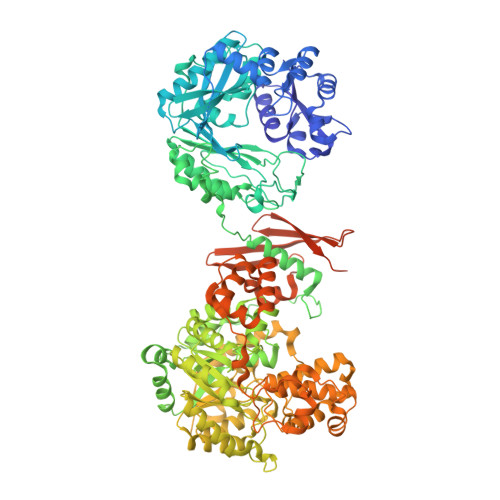Structural and functional studies of pyruvate carboxylase regulation by cyclic di-AMP in lactic acid bacteria.
Choi, P.H., Vu, T.M.N., Pham, H.T., Woodward, J.J., Turner, M.S., Tong, L.(2017) Proc Natl Acad Sci U S A 114: E7226-E7235
- PubMed: 28808024
- DOI: https://doi.org/10.1073/pnas.1704756114
- Primary Citation of Related Structures:
5VYW, 5VYZ, 5VZ0 - PubMed Abstract:
Cyclic di-3',5'-adenosine monophosphate (c-di-AMP) is a broadly conserved bacterial second messenger that has been implicated in a wide range of cellular processes. Our earlier studies showed that c-di-AMP regulates central metabolism in Listeria monocytogenes by inhibiting its pyruvate carboxylase (LmPC), a biotin-dependent enzyme with biotin carboxylase (BC) and carboxyltransferase (CT) activities. We report here structural, biochemical, and functional studies on the inhibition of Lactococcus lactis PC (LlPC) by c-di-AMP. The compound is bound at the dimer interface of the CT domain, at a site equivalent to that in LmPC, although it has a distinct binding mode in the LlPC complex. This binding site is not well conserved among PCs, and only a subset of these bacterial enzymes are sensitive to c-di-AMP. Conformational changes in the CT dimer induced by c-di-AMP binding may be the molecular mechanism for its inhibitory activity. Mutations of residues in the binding site can abolish c-di-AMP inhibition. In L. lactis , LlPC is required for efficient milk acidification through its essential role in aspartate biosynthesis. The aspartate pool in L. lactis is negatively regulated by c-di-AMP, and high aspartate levels can be restored by expression of a c-di-AMP-insensitive LlPC. LlPC has high intrinsic catalytic activity and is not sensitive to acetyl-CoA activation, in contrast to other PC enzymes.
Organizational Affiliation:
Department of Biological Sciences, Columbia University, New York, NY 10027.
















